|
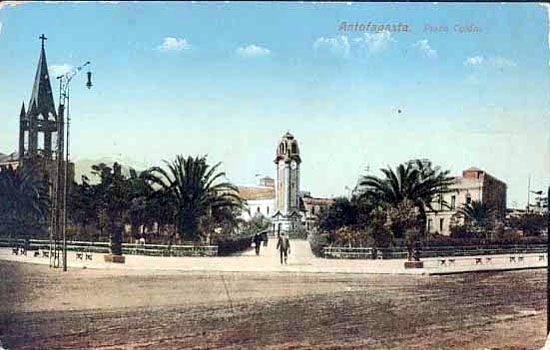
Antofagasta, Chile, approx. 1920
Antofagasta is in the north of Chile 1,364 km. from Santiago. At one time
the port city was a part of Bolivia.
During the Guerra Del Pacifico (The War of the Pacific, 1879-1883) between Chile,
Peru and Bolivia, Antofagasta on the Pacific Coast was
seized by Chile, leaving Bolivia land locked. Additionally, Chile seized what had been
Peru's Tarapaca Provence. As indicated on the
preceding page, after leaving Argentina, Butch and Sundance are believed to
have reverted to a life of crime.
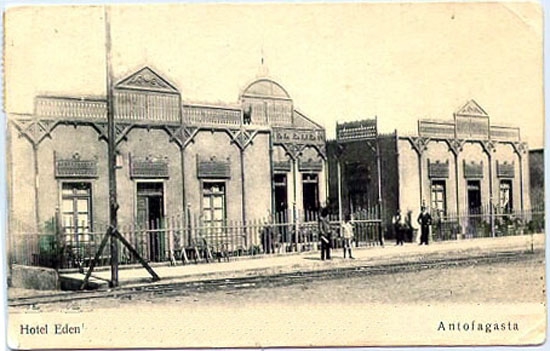
Hotel Eden, Antofagasta, 1909
Among places where it is believed they stayed in
Chile was Antofagasta. Richard Patterson in Butch Cassidy: A Biography, University of Nebraska Press, 1998, suggests
based on Pinkerton records that Sundance going by name of "Frank Boyd" had gotten
into a difficulty there. The Pinkertons apparently bribed a local post office worker in
Pennsylvania to covertly open mail addressed to Sundance's family and, thus,
ascertain his location. According to Jose Steinsleger, writing in the
La Jornada de Mexico, as quoted in El Mercurio Calama, August 5, 2001, the duo
robbbed the Banco de Antofagasta two years before their reputed demise in
San Vicente, but things
went badly. Butch broke a leg when his horse was killed by the police, but he
was able to escape. According to Steinsleger, the two also were in Santiago de Chile in
1907, prior to the robberies of the Mercantile Company of Chubut and the National Bank of
Villa Mercedes. Nevertheless, Steinleger's account is open to some question. Daniel Buck and
Anne Meadows spent considerable time going through newspaper accounts in Antofagasta and were unable
to find any accounts of the purported bank robbery. Buck suggests that the account of the broken
leg might be confusion with an alleged unconfirmed jail escape in Peru.
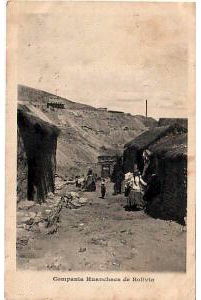
Compania Huanchaca, Bolivia, 1912
In 1890, a railroad was constructed from Antofagasta connecting to the tin and lead mines in
Bolivia owned by the French-owned Compania Minera de Huanchaca near Oruro. On this train would be borne silver from the
mines and payrolls from Chile. According to
Charles Kelly in The Outlaw Trail, A History of Butch Cassidy & His Wild Bunch, University of
Nebraska Press, Lincoln, 1996, the Railroad was robbed near Eucalyptus by Butch and Sundance with an
outlaw named McVey. Additionally, Bolvian sources indicate that the Bank at
Eucalypus was also robbed by the duo. According to Kelly, Cassidy had planned on robbing the
the Scottish-owned Huanuni Mine. but didn't due to the hospitality with which he was greeted. Instead, he took
employment in charge of the watchmen. In fact, the mine was robbed in 1906, but by a New Yorker maned Scott.
Kelly also quotes a letter to noted western writer Maxwell Struthers Burt from mining engineer W. L. Bell suggesting that
two Wyoming members of the Hole-in-the-Wall gang were planning on robbing a Peruvian gold mining operation in
1907, but had been pursued out of the area.
There is, of course, doubt as to which robberies were conducted by Butch and Sundance. As Daniel Buck has
noted, the Pinkertons tended to attribute every robbery in South America committed by
Norte Americanos to Butch and Sundance. Indeed, as noted by Kelly, the two have been blamed for the robbery
on December 17, 1910, of
a store at Arroyo Pescado in which the manager was killed.[Kelly places the date as given, but does not give the the name of the store or
manager. The Welsh owned Cooperative Mercantile was robbed on December 29, 1909, and the store manager,
Llywd Ap Iwan (Lloyd Jones) was killed]. Arroyo Pescado, in Chubut lies to the southeast of Cholila.
An unconfirmed local legend has it that Butch and Sundance killed a Welsh settler near Arroyo Pescado in 1903.
As Kelly further notes, it is
improbable that the two committed the assualt on the Arroyo Pescado Store, in that they are believed to have already gone to
meet their Maker at the time.
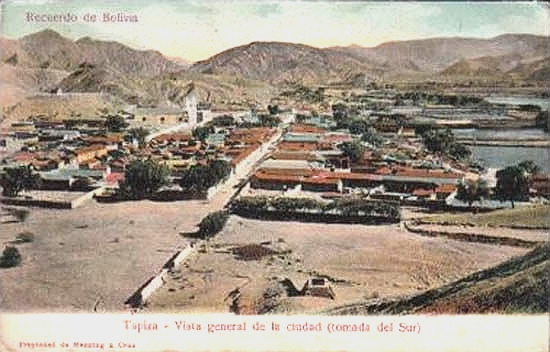
Tupiza, Bolivia, approx. 1910.
On November 4, 1908, at Huaca Huanusca Hill, outside of Tupiza, in the extreme southern part of
Bolivia, two English speaking bandits stopped at gun point Carlos Peró, who was bearing the
payroll for Aramayo, Francke y Cia., an important tin mining company. The two bandits had
been staying at a camp 15 miles south of Tupiza on the Rio de San Juan del Oro. After relieving Peró of
the payroll, the bandits made good their escape taking with them an Aramayo branded mule. Shortly thereafter,
Peró was able to relay word and authorities throughout the area were notified by telegram of the
robbery. Three days later, two English speaking men with the Amamayo mule appeared in the
small tin mining town of San Vicente. The town within the Altiplano of Bolivia, at 4,500 meters in elevation, was isolated and
desolate. The tree-less dun colored landscape is interrupted only by the occasional ichu grass.
Today, the town remains isolated. There is no public transportation to San Vicente, except a truck which leaves on Thursdays from
Tupiza for the three hour trip up the unpaved "road." But for that matter,
Tupiza, itself, is isolated, accessable by bus over unpaved highway or by train. As the writer's younger
son has noted after a trip across the Bolivian Andes on a road he referred to as
el camino de la muerte, "But long it took 14 hours to go 200 miles. I've seen forest service
roads better then this." The truck to San
Vicente does not necessarily return the next day and accomodations can best be
described as "basic." The area does, however, bring new meaning to the term "Big Sky Country."
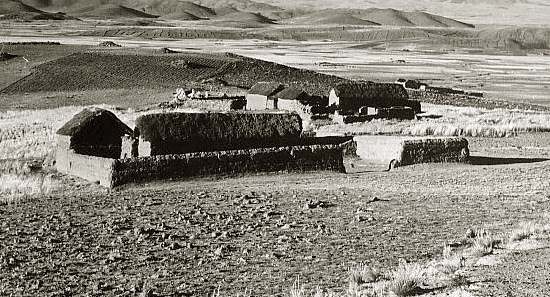
Town in the Altiplano of Bolivia, 1930's
The two came upon Cleto Bellot, unbeknownst to the two, the local magistrate and inquired after
lodgings. Bellot indicated that the two could stay in the house of Bonifacio Casaola, a one-room
thatched adobe structure or cabin. Also unbeknownst to the two was that earlier in the
day a four-man posse, consisting of two soldiers, a police inspector, and an
army captain had arrived, looking for the bandits. Bellot informed the captain.
Two soldiers approached the house, several volleys of shots were exchanged, one shot striking one of the
soldiers, Victor Torres, in the neck. Shouts were also heard from within the
the Casaola cabin. Torres was taken to a nearby cabin where he died.
After midnight no more sounds were heard from the house. In the morning, local
soldiers cautiously approached the house and peered within. The two bandits were dead and were
unceremoniously buried in the local cemetery. Controversy exists today as to
whether the two were killed in the exchange of shots or whether it was
suicide to avoid a Bolivian jail. Two weeks later, as a part of an
inquest, the two desconcides (unknowns) were disinterred for identification by Peró as the two who had stolen
the payroll. Following 1908, letters from Butch to his family in the United States ceased.
Many writers now claim that the two bandits were
Butch Cassidy y Sundance The Kid, los famosos asaltantes de bancos yankees. (Other towns also
claim to have been the location of Butch's and Sundance's demise.) Indeed,
at one time if one was intrepid enough to make the trek to San Vicente, one would have been greeted by a sign
which proclaimed: "Centro Minero
San Vicente
Deaths Butch Kasidy
Sundance the Kid."
The sign has since been repainted and the spelling and grammer corrected. See next photo.
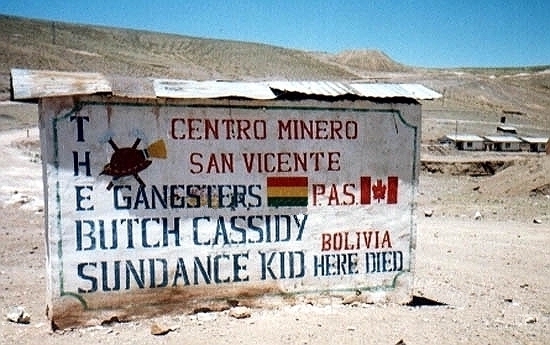
El Signo Acogedor,
Welcoming Sign, San Vicente
The "P. A. S." and the Canadian flag is for Pan American Silver Corp., a Canadian corporation that
has mining interests in San Vicento.
In 1930, an article written by Arthur Chapman appeared in the Elks Magazine contending that the two were in fact Butch
Cassidy and the Sundance Kid. A furious controversy then began which continues
unabated to this day. The basis for the believe that Butch and Sundance died in the
adobe cabin rests on the undeniable fact that the two were in South America at the time, and the rememberances of
Percy Seibert, a mining engineer for whom the two worked in Bolivia, and
A. G. Francis' 1913 article The End of an Outlaw, Wide World Magazine.
The two provide much light on the subject. Seibert had met the two at the Gran Hotel in
La Paz (see postcard view next page) and subsequently employed them as guards at the Concordia Mine. Francis was working
on a dredge on the Rio de San Juan where the two camped. However, Francis believed that the
two killed in killed in Bolivia were Kid Curry and Butch Cassidy. Seibert identified the place
of demise in San Vicente, but describes a scene more like the finale of the movie
Butch Cassidy and the Sundance Kid. Chapman, based on Seibert's memory, has
Cassidy and Sundance lodging for the night at a combination police station and inn. The constable
at the police station recognizes the Aramayo mule and summons 20 cavalrymen who are camped outside of town. The captain of the
cavalry enters the police station and demands the surrender of Butch and Sundance and is shot dead. The police
station is then beseiged:
Cassidy and Longabaugh were firing rapidly and with deadly effect. Those of the
detachment who remained on their feet were firing in return. bullets sank into the
thick adobe walls or whistled through the windo and door. Other soldiers began
firing from behind the shelter of the couryard wal.
"Keep me covered, Butch," called Longabaugh. "I'll get our rifes."
Shooting as he went, Longabaugh lurched into the courtyard. If he could only
reach the rifles and ammunition which they had so thoughtlessly laid aside, the
fight would be something the outlaws would welcome.
Blood was settling in little pools about the courtyard. The sergeant and most of his
file of soldiers were stretched out dead. A few wounded were trying to crawl
to safety. The mules had broken their halters and galloped out of the yard,
among them the animal which had been the indirect cause of the battle.
Soldiers were firing through the open gate and from all other vantage points outside the wall. Longabaugh
got halfway across the courtyard and fell, desperately wounded, but not before he
effectively empties his six-shooter.
* * * *
The battle now settled into a seige. Night came on, and men fired at
the red flashes from the weapons. There were spaces of increasing length
between Cassidy's shots. He had only a few cartridges left. Longabaugh's cartiedge belt
was empty. So was the dead Bolivian captain's.
The soldiers, about 9:00 or 10:00 o'clock in the evening, heard two shots fired in the bullet-riddled
station. Then no more shots came.
At noon the next day, according to Chapman, an officer and detachment of soldiers
rushed the police station and found the two dead, Cassidy having killed Longabaugh and used his
last bullet for himself.
Francis' version, however, was not the first version to make it into print. Hiram Bingham, American missionary,
archeologist, explorer, aviator, politician, discoverer of the site of the Vitcos the last capital of the Inca, and
the discoverer of the lost city of Machu Piccho, by happenstance two weeks after the events
described above had journeyed to Tupiza. Dr. Bingham was in reality a real-life version of
Indiana Jones. Later, he was the director of the 1911 Yale University expedition into Peru. Dr. Bingham in his 1911 account of his 1908 adventures in South American,
Across South America, An Account of a Jouney From Buenos Aires to Lima By Way of Potosi wrote:
Two weeks before our arrival a couple of bandits, one of whom had been hunted out of Arizona by Pinkerton detectives, had held up a cart containing
twenty thousand dallars, on its way to pay of the laborers in a large mine. The owners, wealthy
Bolivians, immediately offered a large reward for the capture of the bandits, dead or alive, notwithstanding that
the robbers and thier friends, of whom there seemed to be a score or more, let it be
carefully understood that they would take a definite revenge for any lives that might be lost
in pursuit of the highwaymen. This did not deter the mine owners, however, and a party of fifty
Bolivian soldiers went on the trail of the robbers, who were found lunching in an
Indian hut. They had carelessly left their mules and rifles several yards away from
the door of the hut and were unable to escape. After a fight, in which three or
four of the soldiers were killed and as many more wounded, the thatch roof the the hut was
set on fire and the bandits forced out into the open where they finally fell, each with half a dozen bullets in his body.
But were the two Butch and Sundance? Dr. Bingham also wrote,
"Soon after our arrival at La Quiaca, at 9 P.M. on November 15, 1908, we received a call from
two rough-looking Anglo-Saxons who told us hair-raising stories of the dangers of
the Bolivian roads where highway robbers driven out of the United States by
the forces of law and order and hounded to death all over
the world by Pinkerton detectives, had found a pleasant resting-place in which to pursue their
chosen occupation without let or hinderance. We found out afterwards that on of our informants was one of
this same gang of robbers."
La Quiaca, in Argentina, is on the border on the road to and from Topiza. Were the two Butch and Sundance?
Did the two escape death in San Vicente?
Music this page:
Streets of Laredo
or
The Cowboy's Lament
I
As I walked out in the streets of Laredo,
As I walked out in Laredo one day,
I spied a young cowboy wrapped up in white linen.
Wrapped up in white linen and cold as the day.
II
"I see by your outfit that you are a cowboy."
These words he did say as I boldly stepped by.
"Come sit down beside me and hear my sad story.
I'm shot in the breast and I know I must die."
III
"Oh beat the drum slowly and play the fife lowly.
Play the Dead March as you carry me along.
Take me to the green valley and lay the sod o'er me.
For I'm a young cowboy and I know I've done wrong."
IV
"It was once in the saddle I used to go dashing.
It was once in the saddle I used to go gay.
First to the dram house and then to the card house.
Got shot in the breast and I'm dying today."
V
"Get six joly cowboys to carry my coffin;
Get six pretty maidens to bear up my pall.
Put bunches of reoses all over my coffin.
Put roses to deaden the clods as they fall."
VI
"Go bring me a cup, a cup of cold water
To cool my parch lips," the young cowboy said.
Before I returned, the spirit had left him
And gone to its Maker -- the cowboy was dead
VII
We beat the drum slowly and played the fife lowly.
And bitterly wept as we bore him along.
For we all loved our comrade, so brave, young and handsome.
We all loved our comrade although he'd done wrong.
Next page: "Butch sightings," Milt Hinkle, the end of the Wild Bunch.
|